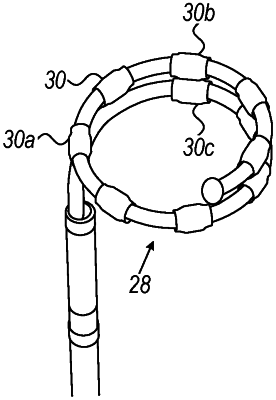| CPC A61B 18/1492 (2013.01) [A61B 2018/00351 (2013.01); A61B 2018/00363 (2013.01); A61B 2018/00375 (2013.01); A61B 2018/00577 (2013.01); A61B 2018/00613 (2013.01); A61B 2018/00892 (2013.01); A61B 2018/126 (2013.01); A61B 2018/1467 (2013.01); A61B 2034/2051 (2016.02)] | 12 Claims |

|
1. A system for detecting contact and proximity between ablation electrodes by sensing changes in voltage morphology of non-activated electrodes, the system comprising:
a pulse generator, which is configured to apply one or more bipolar ablation pulses between a first and second electrode of a catheter that are contacting tissue within a body, for ablating the tissue in contact with the first and second electrodes, wherein the catheter additionally includes a third electrode on which the pulse generator does not apply an ablation pulse; and
a controller, which is configured to: (i) control the pulse generator to apply the one or more bipolar ablation pulses between the first and second electrodes, (ii) monitor voltage between the third electrode and a reference during application of the one or more ablation pulses, wherein the third electrode is a non-active electrode, (iii) compare the voltage to a reference voltage stored in memory associated with the controller, and (iv) issue a notification during application of the one or more ablation pulses in response to detecting that the voltage violates a predefined criterion based on the comparing.
|